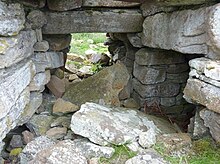Broch by Cinn Trolla
The Broch of Cinn Trolla (also Cill Trolla or Kintradwell ) north of Brora in Sutherland in Scotland lies on a natural terrace , a few kilometers south of Carn Liath between the coastal road ( A9 ) and the railway line .
description
The broch has an inside diameter of 9.3 meters and the preserved inside height of its wall varies from 3 to 4.5 meters (outside a maximum of two meters). At the entrance it is 5.5 meters thick and a 2.4 meter high left standing remnant of the terrace runs around the inside of the exact wall layers made of sandstone . Joass' drawing of the interior shows hand rotary mills arranged around the inner wall . A 2.1 meter deep shaft or well, with a descending staircase, was discovered in the southeast near the wall. Its resemblance to a chamber in Carn Liath is remarkable. Inside the secondary clad wall are two chambers, one of which has a staircase consisting of 13 preserved steps in the 3.05 meter long and 2.75 meter high cell. An oval cell, which can be entered through a small opening in the wall, measures 3.36 meters in length and is 3.05 meters high. During the excavation of the Broch by Joass in 1871, the 2.1 meter high, buried access passage was found on the southwest side. In the 92 centimeter wide corridor there is a narrowing that can be used as a door stop, within which on the right side there is access to the round guard cell (open at the top due to destruction) .
Outbuildings
Outside the Broch, in front of the access, up to a distance of 18 meters, the remains of irregular buildings connected by corridors were found, which Joass assumed to be younger than the actual Broch, as the quality of the masonry was poor is, but since waste material (bones and shells) was built in, this rather points to older construction methods.
Finds
At the time of the excavation, there were deposits inside, consisting of an approximately 1.8 meter high accumulation of ash and earth on the original pavement. In the middle was a flat, fire-blackened stone slab; apparently a fireplace, near which was an L-shaped formation of pebbles set in the ground. Thereupon there were shattered bones in a heap of ash. Between this formation and the south wall there was an area with “double paving”.
The finds from the brochure consisted of an iron spear, an iron dagger blade and a ring (all found during burials in the wall chambers, on the stairs and in the upper floor), a piece of a small iron dagger blade and a chisel-shaped tool, (from the outbuildings) as well Slate rings and discs (no bronzes) are in the Dunrobin Museum.
literature
- Robert Gourlay, Sutherland - a historical guide , Birlinn, Edinburgh, 1996 ISBN 1-874744-44-0 p. 74
- T. Romankiewicz: The Complex Roundhouses of the Scottish Iron Age: An architectural analysis of complex Atlantic roundhouses (brochs and galleried duns) with reference to wheelhouses and timber roundhouses , (2011)
- JNG Ritchie: Brochs of Scotland . Princes Risborough, Shire Archeology secund edition 1998, ISBN 0-7478-0389-7 p. 18
Web links
- Description Engl.
- Detailed description engl.
- Entry on Cinn Trolla's Broch in Canmore, Historic Environment Scotland's database
Coordinates: 58 ° 2 ′ 55.7 " N , 3 ° 48 ′ 56.4" W.

